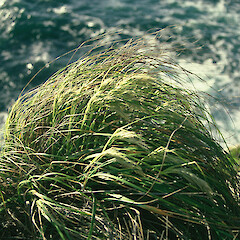Chionochloa bromoides
Common name
coastal tussock, seabird tussock
Synonyms
Danthonia bromides Hook.f.
Family
Poaceae
Flora category
Vascular – Native
Endemic taxon
Yes
Endemic genus
No
Endemic family
No
Structural class
Grasses
NVS code
The National Vegetation Survey (NVS) Databank is a physical archive and electronic databank containing records of over 94,000 vegetation survey plots - including data from over 19,000 permanent plots. NVS maintains a standard set of species code abbreviations that correspond to standard scientific plant names from the Ngä Tipu o Aotearoa - New Zealand Plants database.
CHIBRO
Chromosome number
2n = 42
Current conservation status
The conservation status of all known New Zealand vascular plant taxa at the rank of species and below were reassessed in 2017 using the New Zealand Threat Classification System (NZTCS) – more information about this can be found on the NZTCS website. This report includes a statistical summary and brief notes on changes since 2012 and replaces all previous NZTCS lists for vascular plants.
Please note, threat classifications are often suggested by authors when publications fall between NZTCS assessment periods – an interim threat classification status has not been assessed by the NZTCS panel.
- Conservation status of New Zealand indigenous vascular plants, 2017 . 2018. Peter J. de Lange, Jeremy R. Rolfe, John W. Barkla, Shannel P. Courtney, Paul D. Champion, Leon R. Perrie, Sarah M. Beadel, Kerry A. Ford, Ilse Breitwieser, Ines Schönberger, Rowan Hindmarsh-Walls, Peter B. Heenan and Kate Ladley. Department of Conservation. Source: NZTCS and licensed by DOC for reuse under the Creative Commons Attribution 4.0 International licence.
2017 | At Risk – Naturally Uncommon | Qualifiers: RR
Previous conservation statuses
2012 | At Risk – Naturally Uncommon | Qualifiers: RR, Sp
2009 | At Risk – Naturally Uncommon
2004 | Range Restricted
Distribution
Endemic. North Island where virtually confined to northern offshore islands and easterly headlands from the Bay of Islands south to the Poor Knights, Chickens and Mokohinau Islands. One westerly outlier occurs at Maunganui Bluff.
Habitat
Coastal on cliff faces, bluffs, rock stacks, and in petrel scrub. Well established plants often have their bases heavily burrowed by sea birds such as diving petrels.
Detailed description
Gynodioecious, stout, pendent often sprawling, bright green tussock with persistent leaves and sheaths. Leaf-sheath to 150 mm, shining yellow, keeled, persistent and entire, becoming fibrous, margin abundantly long hairy below, apical tuft of hairs to 4 mm; adaxially with many minute interrib hairs. Ligule to 1.5 mm. Leaf-blade to 500 × 10 mm, flat or shallowly U-shaped, smooth, persistent, adaxially glabrous except for long hairs on margin below and some short or long hairs, sometimes dense, at base. Culm to 700 mm, internodes glabrous. Inflorescence to 200 mm, very congested; rachis and main branches glabrous but with some long hairs at axils; pedicels short and densely hairy. Spikelets of up to 6 florets. Glumes acute or slightly awned, < adjacent lemma lobes, many prickle-teeth abaxially and a few adaxially; lower to 12 mm, 1–3-nerved, upper to 16 mm, 5-nerved. Lemma to 9 mm; hairs dense at margin and in all internerves though sometimes absent from all or some, less than or equal to sinus, prickle-teeth abundant abaxially and adaxially on lobes and margins; lateral lobes to 5 mm including awn to 3 mm or acute, rarely dividing from awn at sinus; central awn to 22 mm from indistinct straight column. Palea to 10 mm, prickle-teeth abaxially and on flanks. Callus to 1.5 mm, hairs to 5 mm. Rachilla to 0.5 mm. Lodicules to 1.75 mm. Anthers to 5.5 mm in male-fertile flowers, up to 3 mm in male-sterile flowers. Male-fertile flowers with stigma-styles to 3.5 mm, ovary to 1.5 mm. Male-sterile flowers to 5 mm, ovary 1.5 mm. Seeds to 3.5 mm.
Manaaki Whenua Online Interactive Key
Flowering
September–December
Fruiting
November–March
Life cycle
Florets are wind dispersed (Thorsen et al., 2009).
Propagation technique
Can be difficult. Best grown from fresh seed. Plants should be planted where they are to grow as they resent much root disturbance. Best in full sun, in a freely draining soil or on a stone wall. Dislikes humidity.
Threats
Not Threatened. Listed because it is a naturally uncommon, regional endemic.
Etymology
chionochloa: Snow grass
Attribution
Description modified from Edgar and Connor (2000).
References and further reading
Edgar E, Connor HE. 2000. Flora of New Zealand. Vol. V. Grasses. Christchurch, Manaaki Whenua Press. 650 p.
Thorsen MJ, Dickinson KJM, Seddon PJ. 2009. Seed dispersal systems in the New Zealand flora. Perspectives in Plant Ecology, Evolution and Systematics 11: 285–309.





